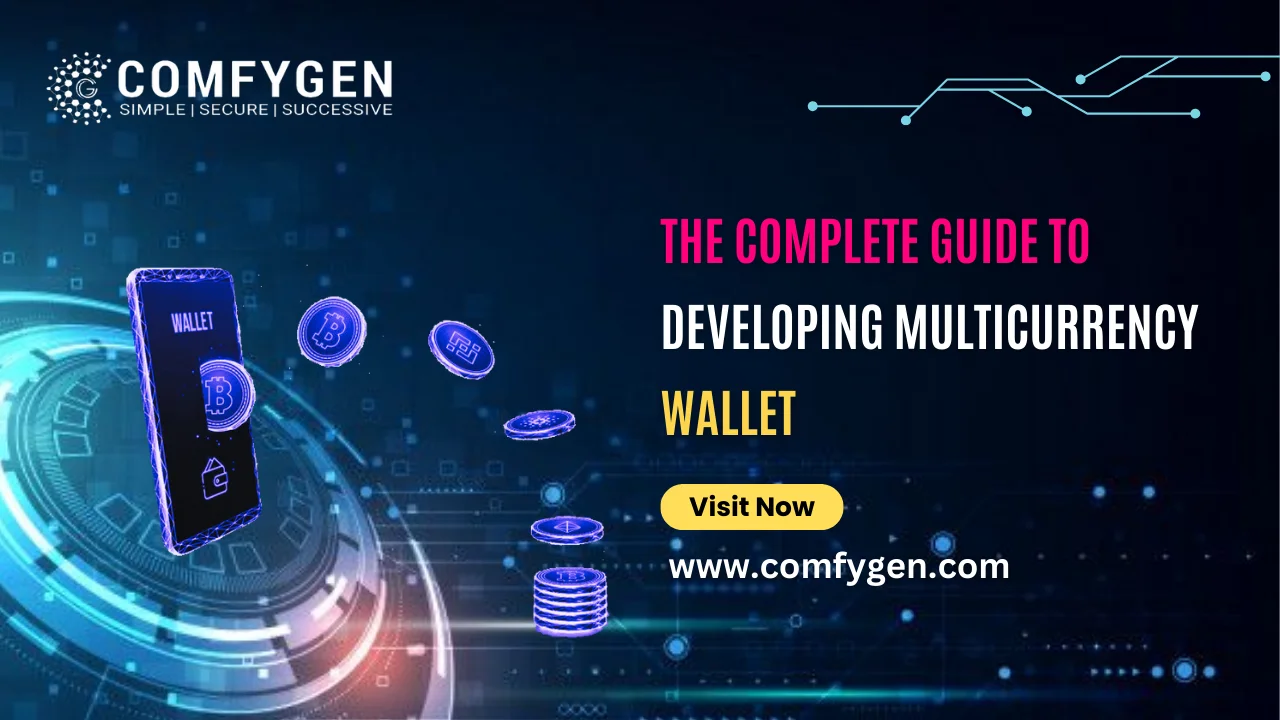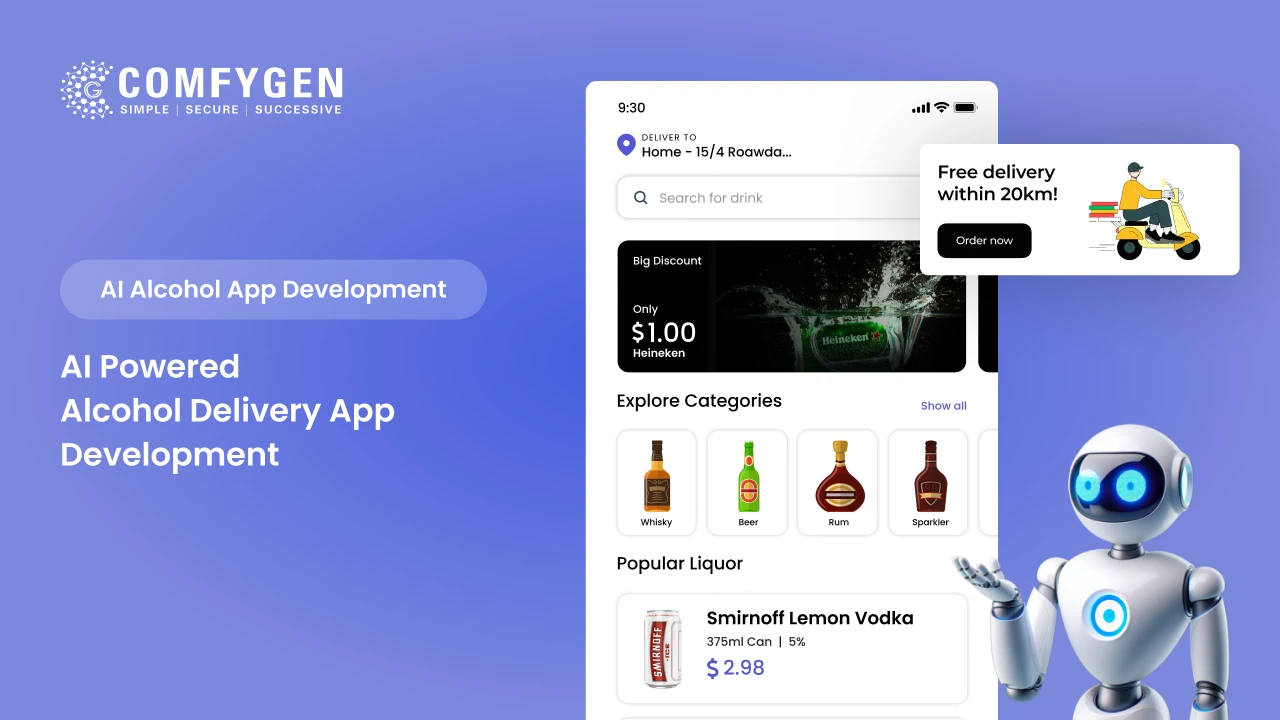The Complete Guide to Developing a Multicurrency Wallet
This comprehensive resource offers an in-depth roadmap for creating a versatile multicurrency wallet. Covering both technical and practical aspects, it walks developers through key steps such as wallet architecture design, security integration, and user-friendly interface development. The guide delves into essential features including private key management, seamless currency exchange, transaction tracking, and cross-platform compatibility. It also explores blockchain integration for various cryptocurrencies, smart contract implementation, and API utilization. By addressing challenges like scalability and regulatory compliance, the guide ensures a holistic approach to wallet development. Whether for personal use or commercial deployment, this guide equips developers with the knowledge to craft a multicurrency wallet that is secure, user-centric, and adaptable to the dynamic landscape of cryptocurrency.
Introduction to Multicurrency Wallets
Multicurrency wallets have emerged as indispensable tools for managing a diverse range of cryptocurrencies on one unified platform. A multicurrency wallet, also known as a multi-asset wallet, is a software application that enables users to securely store, send, and receive multiple types of cryptocurrencies within a single interface. This consolidation of various cryptocurrencies streamlines the user experience by eliminating the need for multiple wallets, each dedicated to a specific coin.
Multicurrency wallets offer a convenient solution for investors, traders, and enthusiasts who engage with a multitude of digital assets. They provide a holistic view of one’s cryptocurrency portfolio, allowing users to monitor their holdings and transactions across different blockchain networks. These wallets can support a wide array of cryptocurrencies, from well-established coins like Bitcoin and Ethereum to lesser-known tokens.
What is a Multicurrency Wallet?
A multicurrency wallet is a digital tool that allows users to store, send, and receive multiple types of cryptocurrencies on a single, unified platform. It eliminates the need for separate wallets for each cryptocurrency, offering convenience and efficiency. These wallets enable users to manage diverse digital assets, ranging from well-known cryptocurrencies like Bitcoin and Ethereum to various altcoin and Tron tokens. Security measures are crucial due to the complex nature of multiple blockchain integrations, ensuring safe storage of private keys and protection against unauthorized access. Multicurrency wallets provide a comprehensive view of users’ cryptocurrency portfolios and simplify their engagement with various digital assets.
Glance Here: How to Choose the Right Altcoin Development Company?
Types of Multicurrency Wallets
Multi-currency wallets are designed to hold multiple types of cryptocurrency tokens in a single wallet. They provide convenience for users who want to manage various digital assets without needing separate wallets for each currency. There are different types of multi-currency wallets available:
Software Wallets:
These are applications that you install on your computer or mobile device. They offer the flexibility of managing multiple cryptocurrencies from a single interface. Examples include Exodus, Atomic Wallet, and Coinomi.
Online/Web Wallets:
Web wallets are accessed through a browser, allowing you to manage your cryptocurrencies from any device with an internet connection. They are convenient but might be considered less secure compared to other options. MyEtherWallet (MEW) is an example of a web wallet that supports multiple currencies.
Hardware Wallets:
Hardware wallets are physical devices that store your cryptocurrencies offline, providing enhanced security.
Mobile Wallets:
They offer portability and convenience, allowing you to manage your cryptocurrencies on the go. Trust Wallet and Jaxx Liberty are examples of mobile wallets with multi-currency support.
Desktop Wallets:
These wallets are installed on your computer and offer a higher level of security compared to web wallets. They allow you to control your private keys locally. Electrum and Jaxx are examples of desktop wallets with multi-currency capabilities.
Paper Wallets:
A paper wallet is a physical piece of paper that contains your cryptocurrency’s public and private keys. It’s an offline storage method that can hold multiple currencies. Generating and using paper wallets requires caution and a proper understanding of the process.
Hybrid Wallets:
Some wallets combine multiple types of wallets to offer a mix of security and convenience. For instance, a wallet might have both software and hardware capabilities.
Blockchain-Specific Wallets:
Some wallets are designed for specific blockchains or cryptocurrency ecosystems. They might support multiple tokens within that ecosystem. An example is the Metamask wallet for the Ethereum blockchain.
Universal Wallets:
These wallets aim to provide a unified interface for managing various cryptocurrencies, regardless of their underlying blockchains. These wallets are designed to streamline the user experience of managing multiple assets. One example is Coinomi, which supports a wide range of cryptocurrencies.
It’s important to research and choose a multi-currency wallet that aligns with your security preferences, usability needs, and the specific cryptocurrencies you intend to store. Always prioritize security by using reputable wallets and implementing best practices for safeguarding your private keys and recovery phrases.
Benefits of Using a Multicurrency Wallet
A multicurrency wallet is a digital wallet that allows you to store, send, receive, and exchange multiple currencies. Here are some compelling advantages to using a multicurrency wallet:
Centralized Management: A multicurrency wallet consolidates multiple cryptocurrencies into a single interface. This simplifies monitoring, tracking, and managing various digital assets, saving users the hassle of maintaining separate wallets for each coin.
Efficient Transactions: Multicurrency wallets facilitate seamless and efficient transactions within a single platform. Users can send and receive various cryptocurrencies without the need to switch between different wallets or interfaces. This saves time and reduces the potential for errors during the transaction process.
Diversification Opportunities: Cryptocurrency enthusiasts often invest in a variety of digital assets to diversify their holdings and manage risk. A multicurrency wallet enables users to explore new and emerging cryptocurrencies without the hassle of creating separate wallets for each one.
Currency Conversion: Many multicurrency wallets offer built-in currency conversion features. This means that users can exchange one cryptocurrency for another directly within the wallet interface. This functionality eliminates the need to use external exchanges and streamlines the process of adjusting one’s portfolio composition.
User-Friendly Interface: Multicurrency wallets are designed with the user experience in mind. They typically provide intuitive interfaces that are easy to navigate, even for individuals who are new to the world of cryptocurrencies. This accessibility encourages a wider adoption of digital assets.
Backup and Recovery: Multicurrency wallets often include backup and recovery options to ensure the safety of users’ holdings. Users are usually provided with recovery phrases or seed phrases that can be used to restore their wallets in case of loss or device failure.
Security and Privacy: While convenience is a key factor, multicurrency wallets also prioritize security. They implement robust encryption, secure key storage, and authentication mechanisms to protect users’ private keys and sensitive data. Users have control over their funds and information, enhancing their privacy.
Overview of the Development Process
The development process involves several key stages to create a robust multicurrency wallet. Beginning with thorough planning and requirement analysis, developers define the wallet’s features and supported cryptocurrencies. The next step is architecture design, where the technical framework and security protocols are established. The developments follow, including front-end and back-end coding, Polygon Integration Services, and wallet functionalities like transaction processing and private key management. Rigorous testing ensures functionality and security, with debugging and optimization as necessary. Once the wallet passes quality checks, deployment takes place, making the wallet accessible to users. Post-deployment, continuous monitoring, and updates are crucial to addressing bugs, security vulnerabilities, and user feedback. Collaboration among developers, UI/UX designers, and blockchain experts is essential throughout the process to ensure a reliable and user-friendly multicurrency wallet.
Understanding Cryptocurrencies
The first cryptocurrency introduced the concept of peer-to-peer transactions without intermediaries. Ethereum expanded this by enabling the creation of decentralized applications and smart contracts. Cryptocurrencies are stored in digital wallets with public and private keys. Transactions are verified by miners or validators, grouped into blocks, and added to the blockchain through cryptographic hashing. Major cryptocurrencies include Bitcoin, Ethereum, Ripple, and Litecoin. Cryptocurrencies have reshaped finance by offering transparent, secure, and borderless digital transactions, while also enabling innovative applications beyond traditional currency exchange.
Basics of Cryptocurrencies
Cryptography is used by cryptocurrencies to ensure safe transactions and control. The original cryptocurrency, Bitcoin, has given rise to a wide variety of cryptocurrencies, including Ethereum, Binance Coin, and others. Peer-to-peer transactions do away with the intermediary. The mining and verification procedures preserve the reliability of the network. Through the use of smart contracts, cryptocurrencies provide the possibility of borderless, censorship-resistant transactions and creative applications. They are both promising financial tools and high-risk investments since their value is prone to volatility and is influenced by market demand, acceptance, and regulatory changes.
Major Cryptocurrencies in the Market
Several prominent cryptocurrencies dominate the market:
Bitcoin (BTC): The pioneering cryptocurrency, Bitcoin, introduced decentralized digital currency and blockchain technology. It serves as a store of value and a medium of exchange.
Ethereum (ETH): Beyond currency, Ethereum is a platform enabling smart contracts and decentralized applications. It’s a driving force for decentralized finance (DeFi) and non-fungible tokens (NFTs).
Binance Coin (BNB): Originally from the Binance exchange, BNB is used for trading fee discounts and accessing various blockchain services within the Binance ecosystem.
Cardano (ADA): Known for its research-driven approach, Cardano aims to provide a scalable, sustainable blockchain platform, focusing on security and interoperability.
Solana (SOL): Solana stands out for its high-speed transactions and scalability, attracting DeFi projects due to its low fees and rapid confirmation times.
XRP (XRP): Developed by Ripple, XRP focuses on fast, low-cost cross-border payments and financial settlement solutions.
Polkadot (DOT): Polkadot facilitates interoperability between blockchains, allowing them to share information and transactions.
Dogecoin (DOGE): Initially started as a meme, Dogecoin gained popularity in its community and has been used for tipping and charitable donations.
Avalanche (AVAX): Avalanche offers a highly scalable blockchain platform catering to DeFi and enterprise applications.
Litecoin (LTC): Often referred to as “silver to Bitcoin’s gold,” Litecoin boasts faster transaction times and has been an enduring presence since 2011.
These cryptocurrencies hold significant value and have distinct use cases, contributing to the diverse and evolving landscape of digital finance.
How Cryptocurrencies are Stored and Transferred
Cryptocurrencies are stored and transferred using digital wallets and blockchain technology. A digital wallet contains a pair of cryptographic keys: a public key, which serves as an address for receiving funds, and a private key, which is used to sign transactions for spending. These keys ensure secure ownership and control of the cryptocurrencies.
Transferring cryptocurrencies involves creating a transaction containing the recipient’s public key and the amount to be sent. Miners or validators verify and group multiple transactions into a block, which is added to the blockchain through cryptographic hashing. This process ensures the integrity and transparency of transactions.
Cryptocurrencies are moved between wallets through these verified transactions, providing a secure and decentralized means of transferring value globally without intermediaries.
Designing the User Interface
Importance of User Experience in Wallet Development
Since user experience directly affects usability and acceptability, it is important when building a wallet. User retention and happiness are guaranteed through responsive design, security features, and intuitive navigation. A satisfactory user experience encourages brand loyalty and attracts new customers, fueling Wallet’s success in a tough industry.
User Interface Design Considerations
The degree of comprehension, and perception of actions and objects, as well as the user’s personal preferences, goals, and skill levels, will all be taken into account when developing something that is “easy” to grasp when it is intended to be used by specific categories of people. In that way, designing an interface is similar to designing any other useful thing. However, while creating a user interface, the following are some particular details to keep in mind.
Security Features for User Interface Design
Incorporating robust security features into user interface (UI) design is paramount to establishing trust and protecting user data in digital interactions. First and foremost, Authentication Mechanisms play a pivotal role. Implementing multi-factor authentication, biometric recognition, or strong password requirements adds an extra layer of defense against unauthorized access.
Data Encryption is another vital component. By encrypting sensitive user information during transmission and storage, UI designers ensure that even if intercepted, the data remains unintelligible to malicious actors.
Effective Error Handling is essential as well. Clear error messages for failed login attempts, incorrect inputs, or other actions guide users while preventing potential security breaches that could arise from repeated attempts to exploit vulnerabilities.
Session Management is equally critical. Introducing features like automatic logouts after periods of inactivity or concurrent session monitoring prevents unauthorized access if a user forgets to sign out or if their device is left unattended.
By integrating these security features seamlessly into the UI design, user trust is bolstered, as they feel their data is well-protected. This not only mitigates potential risks but also contributes to an overall positive user experience, ultimately shaping a secure and reliable digital environment.
Choosing a Blockchain Platform
Selecting a suitable blockchain platform involves assessing factors like scalability, consensus mechanisms, development tools, and community support. Ethereum, with its robust ecosystem and smart contract capabilities, is ideal for decentralized apps. Binance Smart Chain offers high throughput and compatibility with Ethereum projects. Solana boasts high-speed transactions, suitable for gaming and DeFi. Polkadot’s interoperability suits complex projects, while Algorand emphasizes efficiency. Each platform caters to different needs; the choice depends on project requirements, aiming to align technology and goals seamlessly.
Overview of Different Blockchain Platforms
Obtainable blockchain:-Anyone can use public blockchains for transactions, development, or mining because they are open source, decentralized systems. Since there is no centralized authority over their availability, these ecosystems cannot be closed. In the absence of such centralized power, issues of security arise, but not of transparency or suitability.
Personal blockchain:-Permission is required in a private blockchain to conduct transactions, development, or research. These are often developed and used by large corporations. This type of blockchain is simpler to secure and manage, but more challenging to research or audit.
Blockchain hybrid:-Any combination of features provided by both public and private blockchains can be used in a hybrid blockchain. For example, a company can restrict a blockchain’s historical record by obfuscating or hiding important information without completely preventing other blockchain users from accessing the transaction history.
Factors to Consider in Selecting a Blockchain Platform
Consensus mechanisms, scalability, security protocols, developer flexibility, interoperability, and community support are important considerations when choosing a blockchain platform. It is governed by a consensus process. The platform’s ability to handle increasing volumes of transactions is measured by its scalability. Security measures protect against vulnerabilities and attacks. Flexibility in development includes the simplicity of setting up and setting up smart contracts. A blockchain platform that is suitable for certain use cases and long-term success is ensured by evaluating these aspects.
Integration of Multiple Blockchain Networks
Establishing interoperability across different blockchain platforms is essential to facilitate smooth communication between them and the integration of multiple blockchain networks. This is often accomplished using protocols, bridges, or middleware. This integration promotes cross-chain applications and services while maintaining the distinctive properties of each network, promoting better scalability, interoperability, and flexibility within the decentralized ecosystem.
Implementing Wallet Functionality
Implementing wallet functionality involves creating a secure digital wallet to store, send, and receive cryptocurrencies. The wallet generates unique addresses for each coin, enabling transactions. It should offer strong encryption, private key management, and backup options to safeguard funds. User-friendly interfaces enhance accessibility, displaying balances and transaction histories. Integration with blockchain networks ensures real-time updates. From hot wallets for frequent use to cold wallets for added security, implementing wallet functionality necessitates a balance between usability and robust security measures for seamless and safe cryptocurrency management.
Wallet Generation and Key Management
Wallet generation and key management are foundational aspects of cryptocurrency wallet development. When a user creates a wallet, the system generates a pair of cryptographic keys: a public key for receiving funds and a private key for accessing and managing those funds. Securely generating these keys is crucial to prevent unauthorized access.
For key management, wallets can employ Hierarchical Deterministic (HD) key structures. HD wallets derive multiple key pairs from a single seed phrase, enhancing security and simplifying backup. Custodial wallets, offered by some platforms, manage keys on behalf of users, trading off control for convenience.
Handling Different Cryptocurrencies
Wallets need to support various cryptocurrencies to cater to users’ diverse portfolios. Each cryptocurrency operates on its unique blockchain with distinct addressing formats. Wallets must be compatible with these formats to facilitate accurate transactions.
Multi-currency wallets can be single-currency (supporting one type of cryptocurrency) or multi-currency (supporting multiple types). Interoperability protocols like ERC-20 for Ethereum tokens enable wallets to handle various tokens built on the same blockchain.
Transaction Processing and Verification
Transaction processing involves creating, signing, and broadcasting transactions to the blockchain network. The wallet’s role is to securely manage private keys to sign transactions and then submit them for verification. Once a transaction is broadcast, the blockchain’s consensus mechanism ensures its validity.
Verification is a key step to preventing erroneous or fraudulent transactions. The wallet must confirm that the transaction details match the user’s intention before proceeding. Some wallets offer custom transaction fees to prioritize transaction speed, especially during network congestion.
Security Measures in Wallet Development
Security is paramount in wallet development due to the potential loss of valuable assets. Several security measures are implemented to safeguard user funds:
Private Key Management: Wallets must employ robust encryption to protect private keys. Hardware wallets offer an additional layer of security by keeping keys offline.
Two-Factor Authentication (2FA): Adding 2FA enhances login security by requiring an additional verification step beyond a password.
Biometric Authentication: Leveraging biometric data like fingerprints or facial recognition further strengthens wallet access control.
Backup and Recovery: Wallets often provide seed phrases or recovery keys during setup. Storing these offline allows users to recover their wallets in case of device loss.
Cold Storage: Some wallets support “cold” storage, where private keys are kept entirely offline, minimizing exposure to hacking attempts.
Regular Updates: Ongoing software updates ensure that the wallet remains resistant to emerging security threats.
Open Source Auditing: Wallets that are open source can be scrutinized by the community for security vulnerabilities.
Ensuring Security
Ensuring security involves implementing comprehensive measures to safeguard systems, data, and users from unauthorized access, cyber threats, and data breaches. It encompasses employing encryption protocols, enforcing strong authentication methods, conducting regular vulnerability assessments, and maintaining up-to-date security patches. Establishing proper access controls, monitoring network activities, and educating users about best security practices are crucial. Additionally, staying vigilant, adapting to evolving threats, and fostering a security-conscious culture contribute to a resilient defense against potential risks and ensuring the integrity, confidentiality, and availability of digital assets and information.
Common Security Risks in Multicurrency Wallets
Multicurrency wallets, while convenient, can expose users to various security risks that demand vigilant precautions. One risk is Phishing Attacks, where malicious actors use deceptive websites or emails to steal login credentials. Malware and Keyloggers can compromise security by capturing sensitive information. Man-in-the-middle (MitM) Attacks intercept communication between the wallet and the network. Furthermore, Exchange Vulnerabilities might allow attackers to exploit vulnerabilities in third-party Cryptocurrency Exchange platforms connected to the wallet. Lost or Stolen Devices can grant unauthorized access if the wallet is not properly secured.
Implementing Secure Storage and Encryption:
To mitigate risks, secure storage and encryption are paramount. Wallets should utilize Cold Storage, where private keys are stored offline, and inaccessible to online threats. For online storage, robust Encryption Algorithms should be employed to protect sensitive data from unauthorized access. Encryption also extends to data transmission to prevent interception during communication with the blockchain network.
Two-Factor Authentication and Biometric Security
Two-factor authentication (2FA) adds an extra layer of security. Users must provide a second verification method (like a code from their phone) beyond their password, reducing the impact of stolen credentials. Biometric security, using unique biological traits like fingerprints or facial recognition, adds another level of protection. These methods provide an additional barrier against unauthorized access, especially when combined with strong passwords.
While Fingerprint Authentication is widely adopted on mobile devices, it’s essential to ensure its integration aligns with stringent security protocols. Additionally, Facial Recognition can enhance the user experience but should be coupled with anti-spoofing mechanisms to thwart attempts with photos or videos.
Testing and Quality Assurance
Testing and quality assurance are crucial phases in Blockchain software development that involve systematically evaluating a product’s functionality, performance, and security. Through various testing methods, such as unit testing, integration testing, and user acceptance testing, developers identify and rectify issues, ensuring a reliable and high-quality software product. This process guarantees that the software meets user expectations, minimizes the risk of bugs or vulnerabilities, and enhances overall user satisfaction and confidence in the product’s performance.
Importance of Testing in Wallet Development:
Testing is a pivotal phase in AI based multicurrency wallet development agency that ensures the functionality, security, and usability of the application. It systematically identifies and rectifies potential issues, improving the overall quality of the wallet. Effective testing minimizes the risk of bugs, vulnerabilities, and crashes, thereby enhancing the user experience and trust. Thorough testing aligns with best practices in software development, preventing critical failures that could lead to loss of funds or sensitive data. By simulating real-world scenarios and user interactions, testing validates the wallet’s performance, security measures, and user interface, ensuring a seamless and secure cryptocurrency management experience.
Types of Testing for Multicurrency Wallets:
A range of testing methodologies is employed to ensure a comprehensive evaluation of multicurrency wallets:
Unit Testing: This tests individual wallet components, like functions and modules, in isolation to ensure they function as expected.
Integration Testing: It assesses the interaction between various components within the wallet to verify seamless communication.
Functional Testing: This evaluates the wallet’s features against defined specifications, ensuring that each function operates as intended.
Security Testing: It involves vulnerability assessments and penetration testing to identify and address potential security weaknesses.
Usability Testing: User-centered testing gauges the wallet’s user-friendliness, navigation, and overall user experience.
Performance Testing: This assesses the wallet’s responsiveness, stability, and speed, particularly during peak usage.
Compatibility Testing: It ensures the wallet functions as intended across different devices, operating systems, and browsers.
Regression Testing: This verifies that new changes or features do not negatively impact previously tested functionalities.
Testnet Deployment and Bug Fixing:
Before launching the wallet, it’s crucial to deploy it on a testnet – a blockchain environment that simulates the mainnet without using real assets. This allows thorough testing without risking real funds or impacting the live network. During this phase, bug fixing becomes vital. Identified Issues are addressed, and the wallet is rigorously tested again to ensure the fixes were successful and did not introduce new problems.
Launching and Marketing of the Multicurrency Wallet
Launching and marketing the wallet involves introducing the product to the market and attracting users. It includes strategies like social media campaigns, influencer collaborations, content creation, and partnerships to showcase the wallet’s features and benefits. Building user trust through transparent communication, security measures, and customer support is essential for a successful launch. Effective marketing enhances visibility and adoption, positioning the wallet as a reliable and valuable solution in the competitive cryptocurrency landscape.
Preparing for the Wallet Launch:
Launching a multicurrency wallet requires careful preparation to ensure a successful and impactful entry into the market. Begin by conducting a final round of thorough testing to identify and resolve any lingering issues. Create detailed documentation and user guides to assist users in setting up and using the wallet effectively.
User Experience (UX) is crucial. The wallet should have an intuitive interface and a smooth onboarding process. Performance optimization ensures that the wallet remains responsive even during high-traffic periods.
Additionally, establish a customer support system to promptly address any issues or queries that users might encounter. Set up social media accounts and communication channels to keep potential users informed about the upcoming launch.
Marketing Strategies for Attracting Users:
Effective marketing strategies are key to drawing users to the newly launched multicurrency wallet:
Social Media Campaigns: Utilize platforms like Twitter, Facebook, Instagram, and LinkedIn to share engaging content, updates, and announcements.
Content Marketing: Create informative blog posts, articles, and videos that highlight the wallet’s features, benefits, and use cases. This establishes your authority in the field and educates potential users.
Influencer Collaborations: Partner with cryptocurrency influencers and experts to review and endorse your wallet. Their endorsement can significantly impact user trust and adoption.
Community Engagement: Engage with cryptocurrency forums, communities, and online groups to introduce your wallet and gather feedback. Responding to user inquiries and suggestions builds a positive reputation.
Airdrops and Rewards: Offer initial users small amounts of cryptocurrencies or rewards for signing up, incentivizing them to try out the wallet.
Partnerships and Integrations: Collaborate with cryptocurrency projects, exchanges, or other relevant platforms to integrate your wallet, expanding its reach and usability.
App Store Optimization (ASO): If your wallet has a mobile app, optimize it for app stores with relevant keywords, compelling descriptions, and eye-catching visuals.
Building Trust and Security Reputation:
Building trust and establishing a solid security reputation is paramount in the cryptocurrency space. Consider these strategies:
Transparency: Provide comprehensive information about your company, team, and the security measures employed in the wallet. Transparency builds credibility.
Security Audits: Conduct regular security audits by independent third-party firms. Sharing audit reports with users reinforces your commitment to security.
Educational Resources: Offer educational content about cryptocurrency security, best practices, and avoiding common pitfalls. This empowers users to take proactive security measures.
Customer Support: Offer responsive customer support to address security-related concerns promptly. Users must feel assured that their assets are safe.
Bug Bounty Programs: Encourage ethical hackers to identify vulnerabilities by offering rewards for reporting security flaws. This proactive approach enhances security.
Partnerships with Security Firms: Partner with renowned cybersecurity companies to showcase your commitment to protecting user assets.
User Testimonials and Reviews: Positive feedback from satisfied users reinforces trust, as potential users value real-world experiences.
Regulatory Compliance: Adhering to relevant regulations and compliance standards adds a layer of legitimacy and trustworthiness.
Future Trends and Innovations
Future trends and innovations in the cryptocurrency landscape encompass cross-chain integration, enhanced user interfaces, DeFi integration, and privacy-focused solutions. Advancements in wallet technology will offer seamless management of diverse assets, bridging different blockchain networks. Improved interfaces will simplify user interactions, while integration with decentralized finance (DeFi) protocols will enable users to engage in lending, borrowing, and trading within wallets. Privacy-focused innovations will ensure confidential transactions. These trends reflect the ongoing evolution of the cryptocurrency ecosystem, enhancing accessibility, security, and the user experience.
Advancements in Multicurrency Wallet Technology:
The future of multicurrency wallet technology holds exciting possibilities. Cross-chain integration is a trend gaining momentum, allowing users to manage various cryptocurrencies seamlessly across different blockchain networks. Hardware Wallets are evolving to support more coins and offer advanced security features. Enhanced User Interfaces (UI) are making wallets more user-friendly, and appealing to both newcomers and experienced users. Privacy-focused Wallets are emerging, incorporating advanced cryptographic techniques to ensure confidential transactions. Moreover, advancements in Decentralized Identifiers (DIDs) are anticipated to enhance user authentication and data privacy in wallets.
Integration with DeFi and DApps:
Multicurrency wallets are expected to further integrate with the Decentralized Finance (DeFi) ecosystem and Decentralized Applications (DApps). These integrations provide users with a unified interface to access and manage their assets across different DeFi platforms and DApps. Users can lend, borrow, trade, and interact with various DeFi protocols seamlessly within their wallets. This integration improves the user experience by eliminating the need to navigate multiple interfaces, boosting DeFi adoption, and catalyzing DApp utilization.
Potential Challenges and Opportunities:
As multicurrency wallets evolve, challenges and opportunities arise. Interoperability remains a challenge due to the fragmented nature of blockchain networks, but it also offers opportunities for cross-chain solutions. Security Concerns persist, especially with integration into various third-party protocols, requiring robust security measures and continuous audits. The growing complexity of multicurrency wallets presents an opportunity for enhanced User Education, enabling users to navigate advanced features and security settings effectively. Regulatory Compliance is another challenge, as wallets need to adhere to evolving regulations while maintaining user privacy and security.
How do I send and receive a Decentralized Exchange with a wallet?
Sending and receiving cryptocurrencies on a decentralized exchange development company(DEX) through a wallet involves several steps:
Choose a Wallet: Ensure your multicurrency wallet supports integration with DEXs. Popular options include MetaMask, Trust Wallet, and MyEtherWallet.
Access the DEX: Open your wallet and look for the DEX interface. In some wallets, you might need to connect to a DEX platform, which usually requires wallet approval.
Connect Wallet: Click the “Connect Wallet” or similar button on the DEX interface. This establishes a secure connection between your wallet and the DEX.
Select Assets: Choose the cryptocurrencies you want to trade. Make sure you have sufficient balances in your wallet for the trade.
Place an Order: Depending on the DEX, you can place market orders, limit orders, or other types of trades. Specify the amount and price, if applicable.
Review and Confirm: Verify the details of your trade, including fees and assets. Confirm the transaction through your wallet.
Transaction Confirmation: The wallet will prompt you to confirm the transaction, usually requiring a digital signature or confirmation of the trade details.
Wait for Execution: Once confirmed, the DEX will process your order. The time required varies based on network congestion and blockchain speed.
Received Assets: Once the trade is executed, the received assets will appear in your wallet. Check your wallet’s transaction history for confirmation.
Read More: What is a DEX? How do Decentralized Exchanges Work?
Conclusion
In conclusion, developing an AI Based multicurrency wallet development company demands a comprehensive approach that navigates through each phase of design, development, testing, launching, and future trends. Crafting an intuitive user interface, prioritizing security through encryption and authentication, and facilitating various cryptocurrency transactions are vital components. Thorough testing ensures functionality and minimizes vulnerabilities. A successful wallet launch involves strategic marketing, user education, and building trust. Looking ahead, trends like cross-chain integration, DeFi incorporation, and privacy enhancements shape the wallet’s future. This guide underscores the intricate balance between usability, security, and innovation, enabling developers to create multicurrency wallets that empower users in the dynamic realm of digital currencies.

Mr. Saddam Husen, (CTO)
Mr. Saddam Husen, CTO at Comfygen, is a renowned Blockchain expert and IT consultant with extensive experience in blockchain development, crypto wallets, DeFi, ICOs, and smart contracts. Passionate about digital transformation, he helps businesses harness blockchain technology’s potential, driving innovation and enhancing IT infrastructure for global success.
Based on Interest

Why You Need Creative SaaS Software Developers for a Unique Project?
Businesses across industries are adapting Software-as-a-Service (SaaS) software solutions to streamline organization operations, improve customer experiences, and gain a competitive edge. However,…









